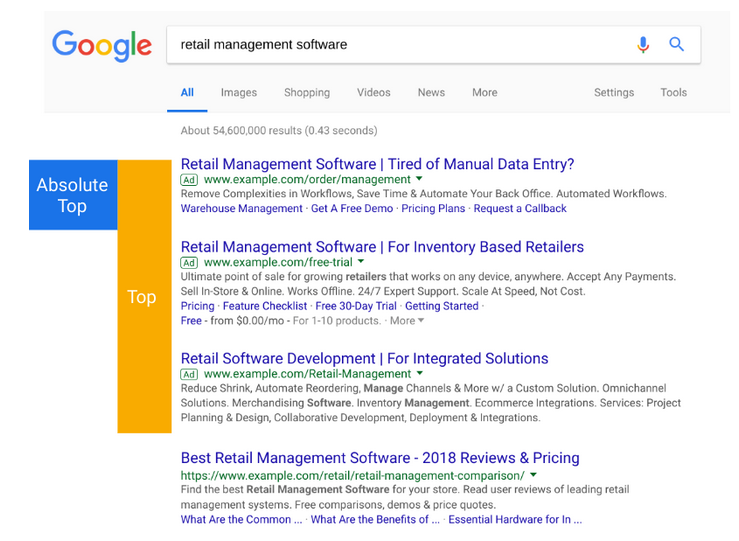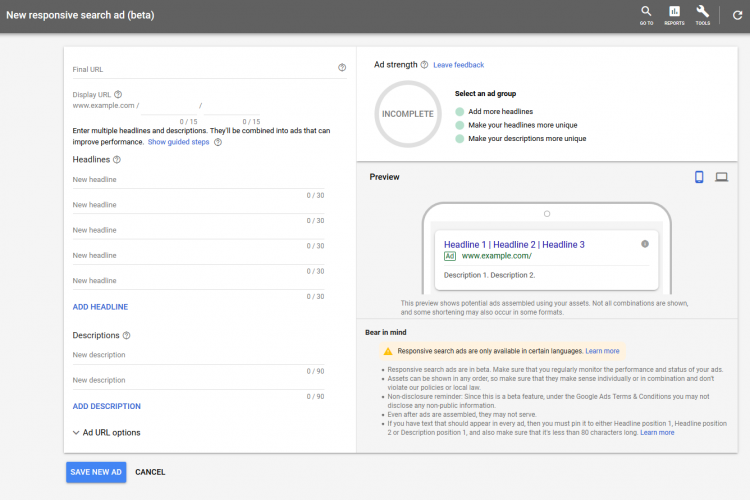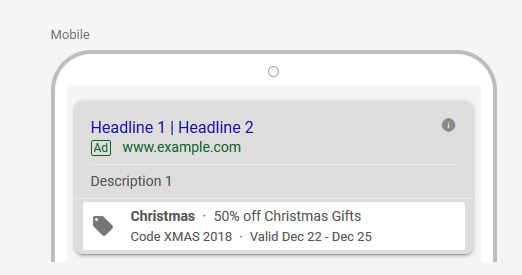Last year, Google may have rebranded their advertising platform from AdWords to Google Ads, but that wasn’t the only significant change that happened in 2018 in the search marketing landscape.
Although there were plenty of new features, tweaks and quality of life changes introduced in the last 12 months, I’ve identified five of the best from Google Ads that I think have been the most useful or impactful.
1. New Search Ad Position Metrics
In November, Google introduced new search ad position metrics to give additional information on where exactly your ads were showing on SERPS:
- Impr. (Absolute Top) % – percentage of ad impressions shown as the very first ad above organic search results.
- Impr. (Top) % – percentage of ad impressions shown anywhere above the organic search results (what you might typically imagine the first 1-3 results on SERPs to be).
- Search (Absolute Top) IS – the number of impressions received in the absolute top location (i.e. position one on SERPs) divided by the estimated number of impressions that you could have been eligible to receive in the top location.
- Search (Top) IS – the number of impressions you’ve received in top positions (anywhere above organic search results) compared to the estimated number of impressions you could have been eligible to receive in the top location.
This is best illustrated in the following image that Google has provided on the matter:

Previously, the only metric we could use to gauge this was average page position. As Google themselves have explained, the common misconception over this metric is that it doesn’t necessarily reflect where on the page your ad would appear, only its rank in comparison to other paid ads.
As an example, if you saw an ad with an average position of 1.5, you would expect this ad to show right at the top of the page the majority of the time. In actuality, whilst it may be the top ranking ad, what you might find is that position one for that particular auction might still be the bottom of the page, below all other organic search results.
These new metrics allow a better understanding of where exactly your ads may be showing on the page, not only in relation to other paid ads in the same auction, but also related organic listings that previously would have been unaccounted for.
2. Expanded Text Ads Changes
Since they were introduced in 2016, Expanded Text Ads have been a fantastic upgrade over the previous, standard ad format we had been using. At the time, they offered advertisers more space to convey their message and we also saw some noticeable improvements to performance and click-through rates alongside these changes.
Not content with the additional space we were afforded, Google decided to further increase the potential size of Expanded Text Ads. Where once we had to contend with just two headlines and a single description, now you can utilise up to three headlines and two descriptions in a single ad.
In practical terms this offers up to 90 characters across three headlines and 180 characters across two descriptions in order to convey your message and differentiate your offering from other competitors.
You can see an example of an ad fully utilising the new features below:

3. Responsive Search Ads
But Google didn’t just stop at the changes to Expanded Text Ads last year, they also elected to introduce an entirely new ad format in the form of Responsive Search Ads. Although this ad format is currently still in beta and thus not available to all advertisers yet, in my experience they are certainly a useful and powerful addition in your paid search arsenal.
As every paid search advertiser will know, A/B testing ad copy is one of the fundamental aspects of optimising any successful PPC account in the long-term. Constantly testing and refining your ad copy ensures that the most relevant and impactful messaging is being utilised – this is one of the best ways to see incremental improvements over time.
This can however be time-consuming and complex, particularly in a large account that offer a wide variety of services or products.
Enter Responsive Search Ads. Rather than creating multiple ads with different messaging and testing these combinations against each other, Responsive Search Ads take all the manual grunt work away by automating the entire process.
Responsive Search Ads themselves show in the same manner as Expanded Text Ads, in that they offer up to three 30-character headlines and up to two 90-character description fields. However, when creating the ad you can input up 15 different headlines and up to 4 different descriptions.
AdWords will then selectively use different combinations of these headlines and descriptions over time and will then start to show the combinations that have shown the best performance. So rather than having to analyse and think of all those different ad copy combinations yourself, Responsive Search Ads will take all the information you give it and A/B test for you.
Plus, with 15 different headlines and 4 descriptions, a single ad could potentially deliver up to 43,680 unique combinations of ad copy. Imagine trying to manually A/B test all of those!

4. Promotion Extensions
Out of any other feature on this list, promotion extensions are a personal favourite of mine. Rather than having to awkwardly shoehorn limited time offers into ad copy or sitelink extensions, we now have access to an entirely separate ad extension designed specifically for this purpose.
This is great for ecommerce clients, particularly during busy times of the year. Black Friday and Christmas are great examples, where deals commonly run for very limited periods of time but potentially offer huge savings and incentives for users to click on your ad.
The template is extremely intuitive, asking you to provide details such as what item is on offer, if a discount code is required, whether the saving is percentage or monetary based, whether the promotion is associated with a particular occasion (such as Halloween or Christmas), and also if a minimum order value is required. Then you just pop your landing page URL in, specify the dates the promotion is active between and away you go!
My one small criticism of this feature is the fact that you can’t currently specify a discount code in tandem with a minimum order value. Curiously the system only allows you to communicate one or the other at once but not both at the same time. However, aside from this minor quibble, I think that promotion extensions are a great addition, letting you communicate very specific offers in your ads without it detracting from or replacing your existing copy.
Here’s how a festive, Christmas offer might look when attached to some example ad copy. Plenty of succinct information that still allows you to write whatever ad copy you’d like alongside it!


5. New AdWords Interface
Finally, we move on to the last and possibly most significant change to Google Ads in 2018, one which has helped facilitate all the changes I’ve mentioned above – the new AdWords interface!
As anyone who knows me can attest to, I generally dislike change. Often this is because I’m stubborn and having to reacquaint myself with something that worked perfectly fine before (thank you very much) feels like a chore!
Imagine my dismay when I discovered that the previously optional new version of the AdWords interface would become mandatory! Despite my initial misgivings however, I have to say that in this instance the change has certainly been for the better.
Not only is the new interface cleaner and easier to navigate, a plethora of new features exclusive to this version have also been introduced including:
- New top level overview pages
- Bid adjustments for calls
- Showcase shopping ads
- Additional scope in audience manager
- Account shortcuts and hotkeys
- New and improved account recommendations (that Google says are actually useful now!)
- Household income targeting in search
- Landing page performance
Discussing all of the changes and impact of the new AdWords Interface could be an entirely separate blog post itself. The short summary though, is that paid advertisers now have more options, information, and control than they have ever had before. What’s more, we also got a swanky new UI to go alongside all of these improvements. Consider me converted!
With Google heavily pushing machine learning right now, I imagine that 2019 will usher in even more examples of time-saving, automated systems and tools to build upon the features I’ve listed above. For now however, 2018 has given us plenty to sink our teeth into to help streamline and optimise our PPC accounts.
Need help with your PPC campaigns? Get in touch today!
